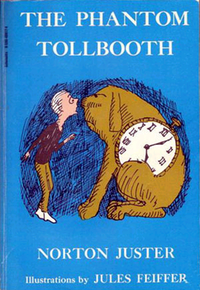
The Phantom Tollbooth, by Norton Juster feels a bit like a blend of Alice in Wonderland meets the Number Devil with a dash of almost (academic non-religious) personified moralism reminiscent of Pilgrim's Progress. The book tells the story of Milo, who travels into the lands of Wisdom and then to find the princesses Rhyme and Reason. Like any good fairy-tale character Milo is given magical gifts which he then uses to find his way past the demons and phantoms that live in the Mountains of Ignorance.
The moralistic aspects of The Phantom Tollbooth pertain largely to making good use of one's time neither waiting at Expectations, nor getting lost in the doldrums where no one thinks, nor caught up in petty tasks and worthless jobs. However there are other little moralistic aspects, including cautions not to jump to (the island of) conclusions, and to be honest in what one says, not exaggerating nor being too frightened to take a stance (like the Gelatinous Giant).
I'm pretty sure a whole curriculum could be developed around the book The Phantom Tollbooth. The following are some ideas I had while reading the book. Some of these I have put to use with my children, some I have not.
The Marketplace of Dictionopolis.
In Dictionopolis words are grown on trees and then sold at the marketplace. Creating a marketplace and play-acting some of the different sellers and buyers allows for exploring all sorts of language arts skills. Some ideas are as follows:
- Create trees and tape words to them. Do different trees grow different types of words? Are they grouped according to the eight types of words, or are they grouped according to word roots, or spelling patterns?
- The Which is imprisoned, so there is no one to help the people of Dictionopolis determined which words to use. Have a stumped resident trying to write a story, asking for help on which words should be used. Use the opportunity to discuss the subtle differences between synonyms.
- What do different letters taste like? Are some sounds softer than others? Talk about their tastes and how alliteration gives flavor to writing.
- Have a "make your own word" station. Talk about the spelling rules for making familiar words and create some crazy ones with new definitions.
- Would you like to buy a pronoun? A stand selling pronouns is a great way to review which pronouns are used for the subject of a sentence and which are used as objects.
- Five of the characters all say the same things in different words. Try acting them out together.
- Have a mock meal at the King Azaz table. Can you produce a light meal? A square meal? What would you order? What speech would you give, knowing you'll have to eat your words? What do you think Milo's meal looked and tasted like?
Forest of Sight
Milo visits the forest of sight where several different types of
sight are looked at. (Pun intended.) What does it mean to look at something? To
look through something? Milo meets Alec, whose family members all "look" in
different ways. "My father sees to things, my mother looks after things, my
brother sees beyond things, my uncle sees the other side of every question, and
my little sister Alice sees under things." Alec himself sees through things, and
thus he bumps into the tree in front of him while looking at the tree beyond
that one. Perhaps he would walk safer if he covered his eyes.
The symphony of colors is another interesting conceit in the
story, as Milo meets the conductor of an orchestra which plays not sound but
colors. After reading this we returned to listening to the Young Person's Guide
to the Orchestra, this time talking about the sounds in terms of what colors and
sights they bring to mind. I think it would also be fun to do some bright
colored painting to music.
There are similarities in the science behind color and sound. If my children were a bit older we would be discussing the doppler effect and redshift, and wave lengths.
Digitopolis
What are numbers? What does it mean for a number to be large? Is a number written with three feet long strings larger than a number written on a play card?
The sections on Digitopolis talk of infinity. When we re-read this book in a few years, I'll use the talk of infinity as a spring-board for talking about Infinity Hotel.


Those are some great ideas! I read Phantom Tollbooth to my then-second-grader last Spring and we both really liked it (I somehow missed reading it myself as a child). But I am looking forward to pulling out the book again in a couple years -- I think my daughter will get so much more out of it when she is just a bit older to really "get" more of the puns.
ReplyDeleteI love your ideas for exploring words with this book. Thank you for linking to Read.Explore.Learn. I will be featuring this post on the Read.Explore.Learn. Facebook page this morning.
ReplyDeleteThanks! Make sure you enter the giveaway!
Delete